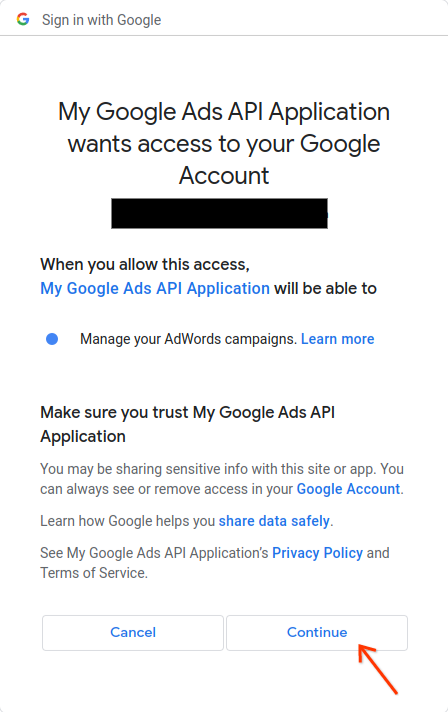Ce guide vous explique comment configurer OAuth 2.0 pour accéder aux API à l'aide de vos propres identifiants et du flux pour ordinateur ou du flux Web. Vous n'avez besoin d'effectuer ces étapes qu'une seule fois, sauf si vous révoquez ou supprimez les identifiants OAuth 2.0, ou si vous devez modifier les autorisations accordées.
Créer des identifiants OAuth 2.0
Suivez la procédure pour configurer un projet dans la console Google APIs pour l'API Google Ads.
Téléchargez le fichier JSON du client en cliquant d'abord sur l'icône Télécharger le client OAuth, puis sur le bouton TÉLÉCHARGER JSON sur l'écran suivant.
Enregistrez le fichier dans votre répertoire d'accueil afin d'obtenir le fichier local
~/client_secret_XXX.apps.googleusercontent.com.json(où XXX correspondra à des valeurs spécifiques à votre projet). Nous utiliserons ce fichier à l'étape suivante pour exécuter l'exemple de code.
Configurez la bibliothèque cliente
Dans un terminal, exécutez l'exemple de code
Vous pouvez utiliser la commande suivante pour exécuter l'exemple de code à partir de la ligne de commande à l'aide de Gradle :GenerateUserCredentials. Utilisez des indicateurs de ligne de commande pour lui transmettre le fichier JSON OAuth 2.0 que vous avez téléchargé../gradlew --console=plain --quiet runExample \ --example="authentication.GenerateUserCredentials \ --oAuthClientFile ${HOME}/client_secret_XXX.apps.googleusercontent.com.json"Cet exemple de code vous invite à accéder à une URL où vous devez autoriser l'application à accéder à votre compte Google Ads en votre nom.
Paste this URL in your browser: https://accounts.google.com/o/oauth2/auth?access_type=offline&client_id=****...Accédez à l'URL dans une session de navigation privée ou une fenêtre de navigation privée. Connectez-vous avec le compte Google que vous utilisez pour accéder à Google Ads. Il s'agit généralement d'une adresse e-mail de connexion à un compte administrateur Google Ads qui contient tous les comptes que vous devez gérer dans sa hiérarchie de comptes. Cliquez sur Continuer sur l'écran de consentement OAuth 2.0.

Vous serez redirigé vers une page contenant un message indiquant que l'autorisation a réussi.
Authorization code was successfully retrieved. Check the console output from `GenerateUserCredentials` for further instructions.-
Revenez à la console dans laquelle vous exécutez l'exemple de code. Vous verrez que l'exemple de code est terminé et affiche votre jeton d'actualisation et quelques instructions, suivies des instructions que vous devrez suivre pour configurer la bibliothèque cliente :
#Mon Apr 18 09:07:51 EDT 2022 api.googleads.refreshToken=1/Yw......................................... api.googleads.clientId=...........-...............apps.googleusercontent.com api.googleads.developerToken=INSERT_DEVELOPER_TOKEN_HERE api.googleads.clientSecret=........................ -
Copiez les lignes du commentaire de date
#à la fin de la sortie dans votre fichierads.properties.Remplacez
INSERT_DEVELOPER_TOKEN_HEREpar votre jeton de développeur.Pour une configuration plus simple, placez le fichier
ads.propertiesdans votre répertoire d'accueil.

